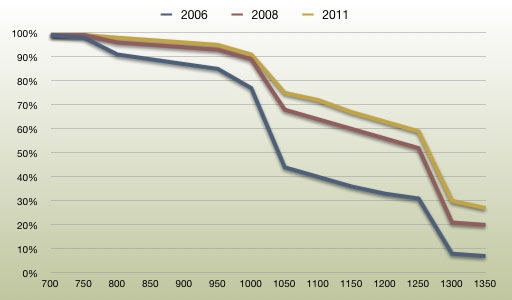Browser widths again again
As someone who has been rambling about the irrelevance of screen resolutions and the importance of browser sizes for years, it is always a pleasure seeing other people get the point.
The other day I was pointed at Liquid Fold, a project that “will provide you a handy set of graphs showing a breakdown of your visitors’ browser sizes”. Anything that improves visibility of this important metric that most statistics packages fail to report is a Good Thing.
Averages aren’t interesting
While the charts provided on Liquid Fold are nice, I don’t really care about the average browser width nor the relation between different browser/OS combinations and browser widths.
I want to know how many visitors do not get a horizontal scrollbar when they view my site.
Time to make a new chart
Seeing how it has been a few years since I last visited these numbers and that Liquid Fold has a huge collection of data points, I figured I’d generate a new chart with their numbers included:

The chart definitely supports the trend we also saw back in 2008; browsers are getting wider, although the difference is far from as significant as it was in 2008. I wonder if the rise of smaller devices like phones and tables have anything to do with this?
Key takeaways from the chart
Let’s look at some key figures. If you make your design 800 pixels wide, only 2% of your visitors will get a horizontal scrollbar. I can live with that. If you make it 960 pixels wide, for example by using the popular 960 Grid System, 6% of your visitors get the dreaded horizontal scroller. That’s getting into iffy territory to me.
And if you make your design 1010 pixels wide a whooping 20% of your visitors have to scroll horizontally to see all your content. Even wider than that and it’s all downhill.
Conclusion?
Unfortunately, it still seems extending your design wider than ~800 pixels is still not something you should just do without thinking about your actual visitors.
But it has gotten easier justifying moving to perhaps 940 or 950 pixels and only annoy around 5% of your visitors.